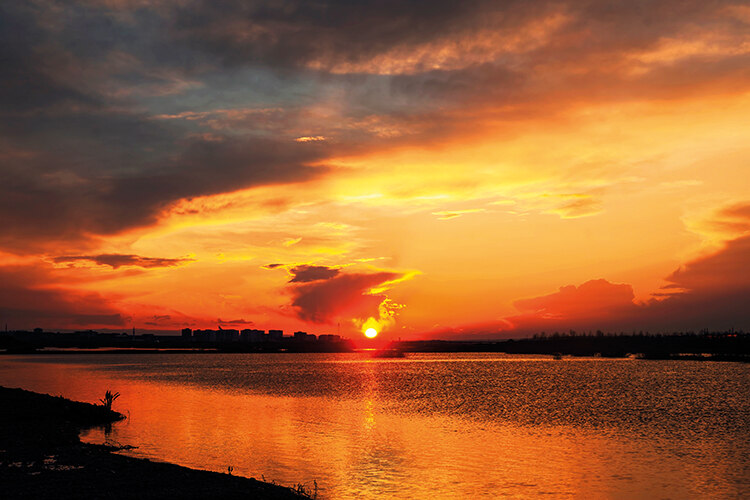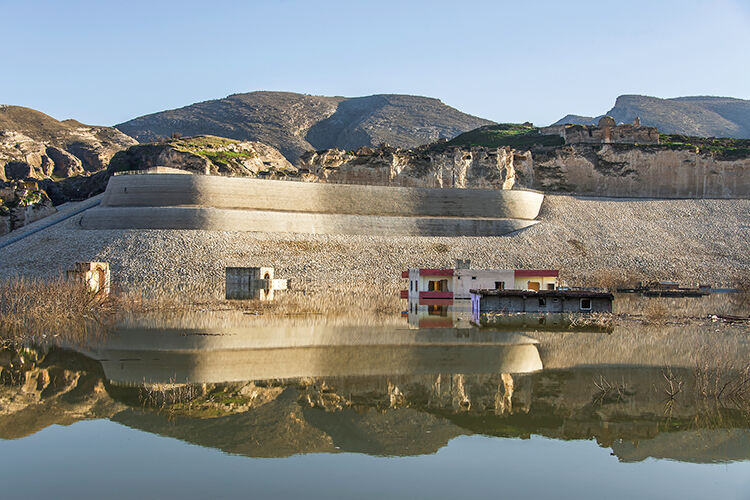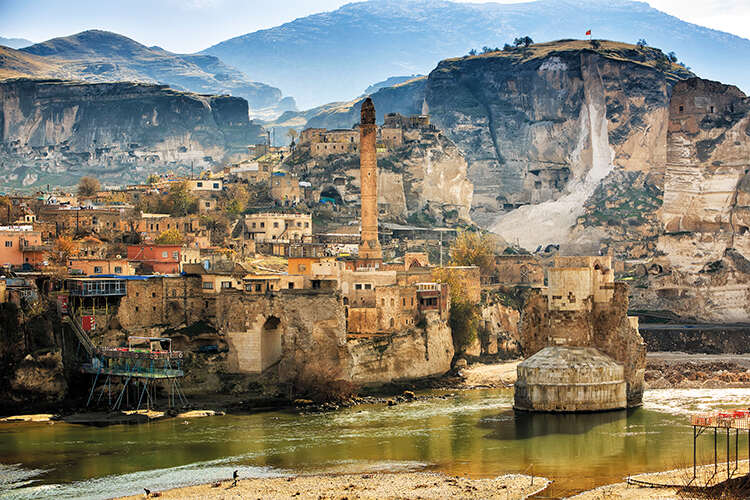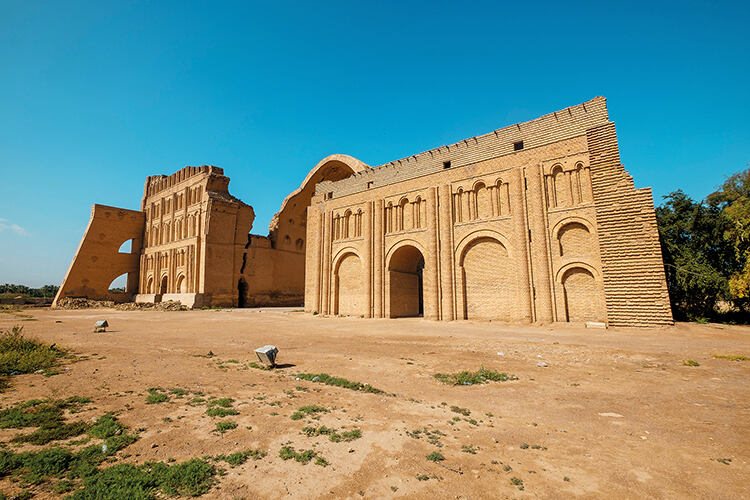
Leon McCarron travelled the length of the Tigris and was astonished by the cruelty of its modern story yet heartened by the hospitality and glimmers of hope that he encountered
In an Iraqi city called Amara, on the east bank of the River Tigris at dawn, around 30 men and women meet by the water. They wear white linen, loose and bound together by belts of rope, and pad around barefoot. The sounds of car horns, loudhailers and muezzins drift across the river as the rest of the city slowly awakens, unaware or unbothered by the ancient ritual about to take place.
The gathered are Mandaeans, who are part of a religious community that, despite some similarities, is completely distinct from Christianity. They claim lineage to Adam, whom it’s said passed on knowledge from the Garden of Eden to only them, and revere John the Baptist as a greater prophet than Jesus. In Amara, they follow the guidance of a priest called Bashir, who tells me: ‘We are the oldest religion in the world.’ There are at least two other religions in Iraq alone that would dispute that, but there’s no doubting they’ve been around for a long time. There are baptisms every Sunday, says Bashir. Most here have been baptised within the last six weeks, which is about as long as Mandaeans feel comfortable without the purification of a baptism.
The women line up first and tentatively follow Bashir into the water. One by one, he gently dunks them into the Tigris. There is no drama, just simple, quiet immersion with a few whispered words. Afterwards, they sit together on a bench and Bashir walks along their line. He carries a wooden stick and green myrtle leaves. A bearded man, Bashir’s assistant, says to me: ‘Life couldn’t start without this water. Rivers and the sea give life.’

For Mandaeans, running water is a divine pathway to heaven and the Tigris is the essence of their faith. They are tied to their life source, but the truth is that the vast majority of the Iraqi population is equally reliant on the river. The need might not always be so sacred, but the dependency for survival, in this realm at least, is the same.
I became interested in following the Tigris when I moved to the Kurdistan region of Iraq in 2019. I was developing a long-distancing walking trail in the mountains and often thought of how the rain that snagged on those ranges would drain to tributaries that ran to the Tigris and eventually washed out into the Persian Gulf.
I travelled to Baghdad and Basra, and spent a few days in the reeded marshlands that I was told might be the Garden of Eden. It was on this floodplain between the Tigris and its sister river, the Euphrates, that our ancestors first began to gather and work the fertile soils adjacent to the river, experimenting with agriculture. From their successes grew the first city-states, 8,000 years ago, and early civilisation blossomed.
The important sites of Iraq, I realised, and Mesopotamia before it, are bound together as products of the Tigris-Euphrates basin. Everything I saw existed because of the rivers and was fastened to them as surely as a boat to a dock.

It was also clear that the rivers are struggling in modernity. To learn why, I spent three months following the Tigris by boat through Turkey, Syria and Iraq. It was not an easy task. It would, perhaps ironically, have been simpler a few thousand years ago. Then, the Assyrians – one of a number of competing powers in antiquity – used rafts to carry goods downstream from the mountains. They even stored wine in the inflated goat skins that gave the rafts buoyancy to keep it cool. Depictions of these rafts can be seen on the 3,000-year-old reliefs that now hang in exile in the British Museum.
It would even have been more feasible just a couple of hundred years ago. The Ottoman-era rafts, called keleks and similar to the Assyrian design, travelled all the way from Diyarbakır in modern-day Turkey to the seaport at Basra. But today the river is fragmented, split between three countries and a semi-autonomous region, and, within Iraq, between various groups vying for control. Our small team included my partner, photojournalist Emily Garthwaite, who was also experienced in Iraq, and filmmaker Claudio von Planta. In Turkey, we had two Kurdish companions – Angel Istek and Bişar Içli – and in Iraq, Salman Khairalla and Hana Ibrahim. They were, variously, journalists, translators, environmentalists and river experts. I knew it was important to journey with people who would be bound to the river in a way that I, as an outsider, never would.
The Tigris rises in the Taurus mountains, where a series of springs feed a stream that disappears into a limestone tunnel and then emerges under the carved relief of an Assyrian king. The fledging river picks up speed as it moves towards Diyarbakır but, as quickly as it grows, it’s compromised. The first attack comes from gravel-mining operations. On countless occasions, all the way into Iraq, we witnessed construction machinery driving around man-made islands, digging out aggregate that’s highly valuable as the primary component of both concrete and asphalt. Its mining changes the shape of a river, makes banks unstable and affects biodiversity in the water and on nearby land. Sand, including gravel, is the second most exploited natural resource in the world after water, and the mines are a scourge on the Tigris. Most are also illegal. As one man from a riparian village asked us, rhetorically, ‘What is a river without its bed?’

Punctuating the mines are the dams. Since the 1970s, the Tigris and Euphrates have been exploited by the Turkish government for energy creation, with an eventual 22 dams built on the headwaters. The development project, one of the largest in the world, is mired in controversy. Most infamous is the Ilısu dam, which recently drowned a town with 12,000 years of human history. Hasankeyf was a capital of the Ayyubid dynasty, established by Saladin himself, and said to be one of the oldest continuously inhabited settlements in the world. It was a nodal point on the Silk Road, with as many as 300 medieval monuments in the valley. A ruined 12th-century four-arch bridge that once spanned the river, and likely carried Marco Polo and the great Ottoman traveller Evliya Celebi across, was survived by two piers and an arch. For 13 years, residents, environmentalists and engineers had come together to protest against Ilısu. They took the case to the European Court of Human Rights. Nothing worked. An estimated 80,000 people were eventually displaced by reservoirs that stretch back 145 kilometres from the dam wall on the Tigris and another 240 kilometres on its tributaries. Habitats and biodiversity areas, which had become even more valuable after similar damage on the Euphrates, were now lost. More than 300 archaeological sites were flooded in the area, along with 200 towns and villages.
We took a boat across the reservoir that submerged Hasankeyf. A man called Ridvan, who had been born in one of its caves, told me: ‘We are now passing history. It’s gone and we’ll all pay the price. If you don’t know your past, how can you know the future?’ The area was ideal for wind- and solar-power installations, he said. As hydroelectric dams are being re-evaluated worldwide, investing in alternative renewables would have been wise, but those suggestions were ignored.
There are many variations of loss along the Tigris. It is a river on which trauma and tragedy flow like rapids.
In Ninewa governorate in northern Iraq, which until relatively recently was occupied by ISIS, the landscape still wears devastation in layers. Settlements often lie in ruins, cement roofs cracked, twisted metal protruding and telegraph poles snapped in two like pencils. The river was empty of traffic and heavily policed by the army and militias. In the city of Mosul, everyone had a story and every story was enough to break a heart in two. A woman called Khitam, standing in the ruins of what was once her home, told how her husband was killed by ISIS, and when the taps stopped running, she took her children to the river to drink. It was all they had, and although they got sick from the pollution, it kept them alive.

Nobody escaped the suffering of that time but, as we were often reminded, the jihadists’ actions were just the latest in a long list of atrocities for Iraqis. There was dictatorship under Saddam Hussein, which saw a bloody, grinding war with Iran, followed by the Gulf War. Then there were sanctions that hit Iraqi civilians hardest and cut the country off from the world. In 2003, the disastrous US- and UK-led invasion tore a gaping hole in the civil service and the country’s infrastructure. That paved the way for various bad actors to step in and catalysed sectarian conflict that has plagued the country ever since. The rise of Al-Qaeda, ISIS and the militia groups that were formed to fight them came as a direct result of that void.
And yet, somehow, perhaps because there was no choice, Iraqis have persevered. In Mosul, a stately Ottoman home by the Tigris has been refurbished as a museum and events space. Those who remade the heritage house are part of a large collective of youth and civil society actively bringing culture back to their country. Salman and Hana, who were with us on the river, were part of that network, and we met their colleagues in every major city and town. The night we left Mosul, we joined students on a weekly litter clean-up along the river.
There are different lenses through which to view the Tigris. For every atrocity, there’s an equally powerful opposing force of humanity, which speaks to the timeless hospitality and openness to strangers displayed by Iraqis and their predecessors. In a village called Safina, an influential tribal sheikh killed two goats and had them served to us on platters of rice. I wondered why the most desirable cuts of meat had to wobble so much, but was grateful for the kindness. As we ate, the sheikh told us the important qualities of a leader. ‘You need three things,’ he said. ‘The first is that you should be a hero.’ He let this sink in. ‘The second is that if anyone asks for anything, you should give it to them. The third is that you should understand everything about justice.’
The sheikh had the means to host visitors, perhaps. Others surely didn’t, yet served us anyway. Even during Ramadan, villagers on the riverbanks insisted on making tea and, when the sun dropped and fasting ended, we were treated like visiting sheikhs ourselves. When the military insisted on accompanying us through areas where there may still have been scattered jihadists, they too were brought tea and evening banquets.

Salman and Hana encouraged me always to remember the light that countered each darkness on the river: the destruction of Mosul and the rebuilding of its cultural monuments; the endless pollution that we saw dumped into the river and the young activists monitoring each site; a massacre in Tikrit, in which as many as 1,700 young airforce recruits were killed by ISIS, and the actions of a woman called Um Qusay, who ferried survivors across the river to safety and hid them in her home.
Heritage of the glorious past remains, too. There are a number of important Assyrian sites, including Nineveh in Mosul, capital of the neo-Assyrians, and Assur on the central river, home of the god that lent his name to the empire. There, a 4,000-year-old ziggurat still stands beside the Tigris, and the three broad mud-brick arches of a processional gateway glowed bronze when we arrived in evening light. Heroic archaeologists watch over these places, with limited resources and staff, often doing so because they understand that this is a shared global heritage that they alone are in a position to protect.
The layers of civilisation slowly disentangle as one moves downstream, from the spiralling, snail-shell minaret of Malwiya in Samarra, built by an Abbasid Caliph 11-and-a-half centuries ago, to the third-century vaulted arch of Taq Kasra, put there by the Persians, now outside Baghdad. So many of the sites of the country remain largely unexcavated. Salem Abdullah, director of the site at Assur, reckoned that as much as 90 per cent of that city still lay underground.
It’s in the south of the country where the challenges that the river faces are seen in starkest relief. In the Mesopotamian marshes, a unique way of life had continued uninterrupted for 5,000 years until Saddam Hussein drained the wetlands during the 1990s. They were re-flooded after 2003, but now cover less than half their historical size. A small population of marsh Arabs can still be found in traditional reed-built homes in the marshes. Most, however, have moved to the margins.
The water levels were lower than they had been in a lifetime, we heard, and what remained was poisoned with pollution and high levels of salinity. One man, Abu Jassim, told me: ‘Our life has always been simple. We just need to be able to look after ourselves and our buffalo.’ But now the buffalo were starving and there were few fish to catch. Abu Jassim wondered whether he would have to leave soon, just as his father had done under Saddam.

but many have moved to cities. Felix Friebe/Shutterstock
Iraq now receives 60 per cent less water from the Tigris than in 2015. That, clearly, is unsustainable. There are regular conferences to attempt to thrash out a water-sharing agreement between Iraq and Turkey, but without results. At the other end of the country, 100 square kilometres of arable land is lost each year to desertification and pastoralists are on the move, heading to already-crowded cities.
From source to sea, we tried to look for hope. It was often difficult. The future of the Tigris and those who live along it feels fragile. Those who can leave often
do. There are now 60,000 Mandaeans living outside Iraq. Those I met in Amara are some of just 5,000 left on the Tigris. The minority communities that have historically made the country so diverse are disappearing. But, as Salman often reminded me, the biggest problem of all for Iraqis was their own poor governance. Even Barham Salih, president from 2018 to 2022, wrote an op-ed recently of the need for ‘root-and-branch reform’.
Iraq needs to move away from its dependency on oil revenue and replace its broken constitution, which serves corrupt kleptocrats. It’s difficult to see how that will happen, but at least in theory, it’s possible.
It’s also a country where the majority of the population was born since the invasion of 2003. To have so many young people, Salman said, can only be a good thing.
This is also the river where civilisations first emerged, where water management was first pioneered. Surely, we must be able to reverse the trend here, or it doesn’t bode well for anywhere else.




